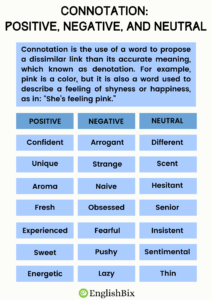Connotation is the use of a word to propose a dissimilar link than its accurate meaning, which known as denotation. For example, pink is a color, but it is also a word used to describe a feeling of shyness or happiness, as in: “She’s feeling pink.”
Connotations can be positive, negative, or neutral. Authors generally use dissimilar connotations to insert many layers of meaning into a word, phrase, or passage. Take this sentence, for example: “The dog is fat.” It has neutral connotations because it simply a statement of fact. However, the same sentence is rewritten as “The dog is chubby” has negative connotations. the word “chubby” implies the dog has a careless owner who doesn’t care.
Now let us work on the types of connotation.
Three types of Connotations in writing:
- Positive connotation. Words that conjure a favorable emotional response. For example, when relating someone ambitious as a “go-getter” or someone who is lively and curious as “youthful.”
- Negative connotation. When a negative connotation is made, it presents the person or a thing in an opposed light. Using the examples above, the same ambitious person might be described as an “overachiever”. while the curious person might be referred to as “childish.”
- Neutral connotation. When a word says what it means with a neutral point of view, and no attached positive or negative. The statement, “He is ambitious” suggests a person works hard and strives to achieve. without judgment on whether ambition is a good or a bad thing.
We should also understand why connotation in writing is important.
Importance of Connotation for Author
Connotation is an important part of the author’s word choice. Words carry weight and can, individually and together, create a certain tone for a sentence, passage, scene, or entire story. it can also be used to:
- Write a multidimensional text. Connotation is useful in creating imagery. For example, the description “He was dressed like an animal” gives the reader a better visual sense of someone’s dress and sense of style than simply saying, “He was messy.” We have 5 types of imagery in English literature where connotations are really useful.
- Develop characters. Readers visualize a story based on the descriptions a writer provides. If a character is described with positive connotations, readers will like them more.
- Draw emotion out of language. Connotation draws emotion out of language, for both the writer and reader.
Examples of Positive, Negative and Neutral Connotations
Following are some examples of connotations:
| Negative | Neutral | Positive |
| Arrogant | Self-assured | Confident |
| Strange | Different | Unique |
| Stench | Scent | Aroma |
| Naive | Inexperienced | Fresh |
| Obsessed | Highly Interested | Infatuated |
| Fearful | Hesitant | Cautious |
| Old | Senior | Experienced |
| Pushy | Insistent | Assertive |
| Lazy | Laidback | Relaxed |
| Skinny | Thin | Fit |
| Mushy | Sentimental | Sweet |
| Hyperactive | Active | Energetic |
Now’s now summarize everything what we have learned using an easy-to-understand image.

Quick Links

